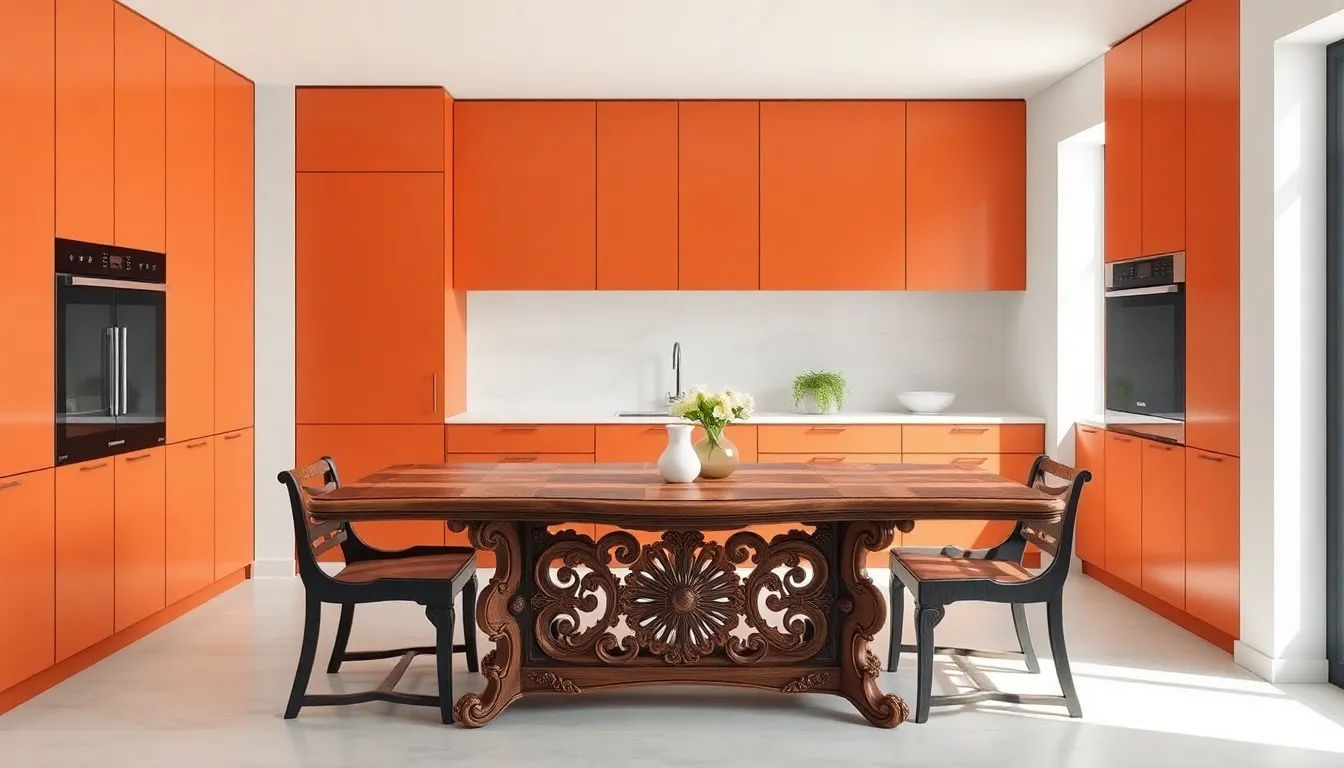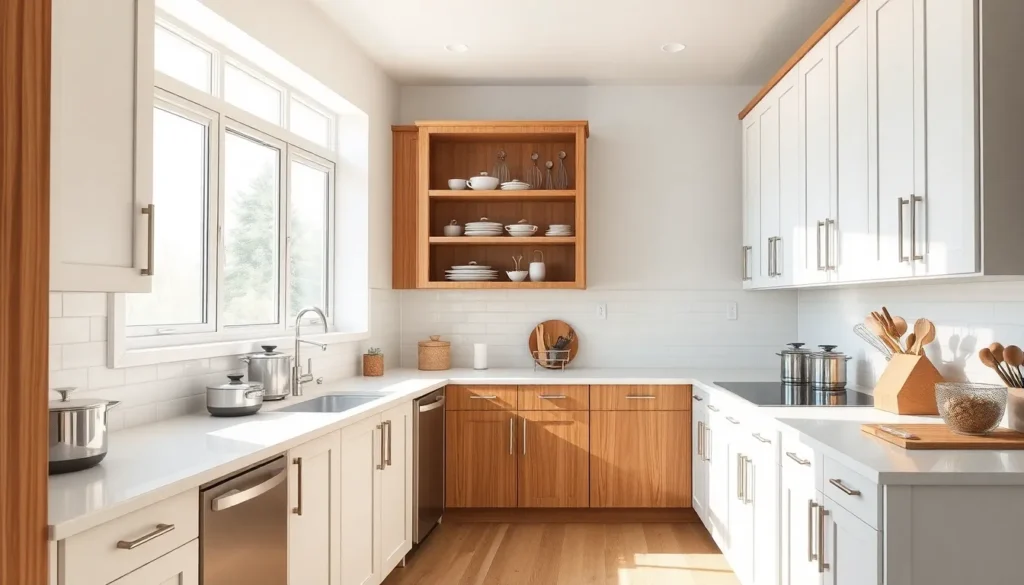A kitchen makeover doesn’t always require a complete overhaul. Sometimes, all it takes is a fresh set of cabinets to transform the heart of the home. Upgrading kitchen cabinets can breathe new life into a tired space, turning it from drab to fab without breaking the bank. Besides, who wouldn’t want to impress guests with a stunning kitchen that screams “I’m a culinary genius!” even if the most complex dish they whip up is toast?
Table of Contents
ToggleBenefits of Kitchen Cabinet Upgrade
Upgrading kitchen cabinets offers numerous advantages, directly elevating the overall kitchen environment. A simple upgrade can transform the aesthetic and functionality of the space.
Enhanced Aesthetics
New cabinets can introduce fresh styles, colors, and finishes, instantly updating the kitchen’s look. They serve as focal points, which draw the eye and create a welcoming atmosphere. Stylish cabinets can complement existing decor while reflecting personal taste. A wide range of materials and designs enables homeowners to customize their kitchens according to current trends. Visual appeal increases when cabinets feature modern hardware, such as sleek handles or elegant knobs.
Increased Functionality
Upgraded cabinets often provide better organization and storage solutions. Improved layouts can optimize space, making everyday use simpler. Features like pull-out shelves, lazy Susans, and built-in dividers enhance accessibility and efficiency. Homeowners can better utilize vertical space with taller cabinets. Streamlined designs minimize clutter, promoting a tidy kitchen environment. Enhanced functionality directly impacts cooking experiences, allowing for smoother workflow.
Choosing the Right Style

Selecting the right style for kitchen cabinets significantly impacts the overall aesthetic and functionality of the space. Both modern and traditional designs offer unique characteristics that cater to different tastes.
Modern vs. Traditional
Modern cabinets focus on clean lines, minimalistic features, and innovative materials. They often emphasize functionality alongside style, with layouts that maximize efficiency. Sleek finishes and bold colors frequently define their look. On the other hand, traditional cabinets showcase intricate details, rich wood tones, and ornate hardware. These options typically exude warmth and elegance, reflecting classic craftsmanship. Homeowners can identify their preferred style by assessing their kitchen’s existing elements and their overall design goals.
Color and Finish Options
Cabinet color and finish choices play a crucial role in defining kitchen ambiance. Bright whites and soft pastels create a fresh, airy atmosphere that enhances small kitchen spaces. Darker hues like navy or charcoal add drama and sophistication. Glossy finishes reflect light and heighten visual interest, while matte finishes provide a more understated elegance. Additionally, wood stains range from light oak to deep walnut, allowing homeowners to match cabinets seamlessly with countertops and flooring. Analyzing personal taste and kitchen layout guides effective color selection, ensuring cabinets enrich the overall design.
Materials for Kitchen Cabinets
Selecting the right materials for kitchen cabinets greatly influences aesthetics and functionality. Common choices impact durability, maintenance, and style.
Wood Choices
Real wood remains a popular option due to its natural beauty and versatility. Oak, maple, cherry, and birch are frequently chosen for kitchen cabinets. Oak offers strong durability, while maple features a fine, smooth grain. Cherry wood ages beautifully, developing an attractive patina over time. Birch provides a budget-friendly alternative that still delivers quality. Cabinets made from solid wood enhance warmth and character, making the kitchen inviting.
Alternative Materials
For those seeking cost-effective solutions, engineered wood products like plywood and MDF offer excellent choices. Plywood consists of multiple layers, providing strength and stability, which reduces warping. MDF is more affordable and offers a smooth surface ideal for painting. Additionally, laminates present a durable finish that can mimic the look of wood without the high cost. Stainless steel and glass components cater to modern styles, offering sleek designs and easy maintenance.
Installation Process
Upgrading kitchen cabinets involves a clear installation process. Proper planning ensures that the project goes smoothly.
DIY vs. Professional Help
Choosing between DIY and professional installation varies based on skill level and project complexity. Homeowners comfortable with tools might consider tackling the project themselves. Installing cabinets requires precise measurements and sturdy support. Assistance from professionals brings expertise to avoid potential pitfalls. Costs for professional installation can vary significantly, influenced by factors like the kitchen size and cabinet type.
Cost Considerations
Upgrading kitchen cabinets presents various cost factors to evaluate. Prices for cabinets depend on material, style, and finish. Solid wood cabinets often range from $100 to $500 per linear foot, while engineered wood options typically cost between $50 and $150. Additionally, labor costs for professional installation can add $70 to $200 per hour, depending on local rates. Budgeting for both materials and installation ensures a successful upgrade.
Maintenance Tips for Upgraded Cabinets
Upgraded cabinets require regular care to maintain their appearance and functionality. Cleaning them frequently helps avoid the accumulation of grease and dirt. Wiping surfaces with a soft, damp cloth keeps the finish intact.
Using mild soap solutions ensures no harsh chemicals damage the material. For wooden cabinets, applying a specialized wood cleaner prevents drying and cracking. Every few months, inspecting hinges and hardware for wear extends their lifespan.
Refraining from overly wet cloths protects against water damage. Avoiding abrasive scrubbers prevents scratches that degrade finishes. When reorganizing, taking care not to overload shelves supports their structural integrity.
Addressing minor dings and scratches immediately keeps cabinets looking their best. Applying touch-up paint or stain repairs any visible flaws. For deeper issues, consulting a professional ensures proper fixes without compromising quality.
Annual maintenance checks can identify any potential problems before they escalate. Tightening screws and replacing worn-out hardware improves functionality. Keeping cabinet interiors organized enhances accessibility and efficiency during meal prep.
Additionally, managing humidity levels in the kitchen supports wood cabinets’ stability. Using a dehumidifier can reduce excessive moisture that may cause warping. Keeping cabinets out of direct sunlight prevents fading from prolonged exposure.
Following these maintenance tips maximizes the longevity of upgraded cabinets. A little upkeep can retain the fresh, inviting appearance of the kitchen’s centerpiece. Appreciation for these enhancements contributes to a beautiful and functional cooking space.
Upgrading kitchen cabinets is a smart way to breathe new life into a kitchen without a full renovation. This simple change can enhance both the look and functionality of the space. With various styles colors and materials available it’s easy to find options that reflect personal taste while improving organization and efficiency.
Proper planning and maintenance are key to ensuring the cabinets remain a stunning focal point for years to come. By investing in quality materials and thoughtful design choices homeowners can create a kitchen that’s not only beautiful but also a joy to use. Making these upgrades can transform the kitchen into a welcoming environment perfect for entertaining or family gatherings.






